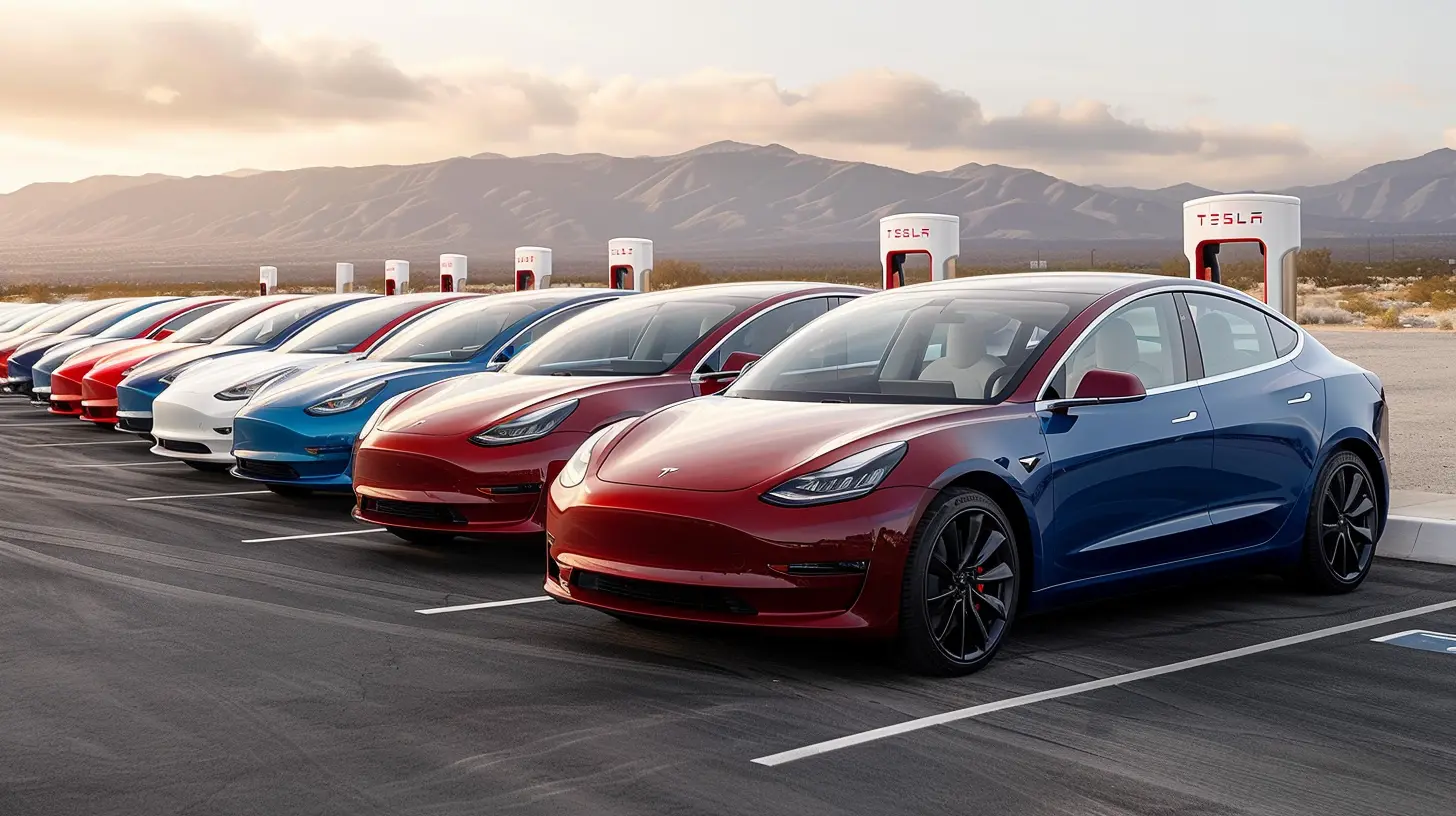The Role of Government in Accelerating EV Adoption
6 June 2025
Electric vehicles (EVs) are no longer a futuristic concept reserved for sci-fi movies. They're here, they're real, and they’re gaining traction fast. But let's be honest: if we left it entirely up to the market, the transition from gas-guzzling cars to eco-friendly EVs would crawl at a snail’s pace. That’s where governments come into play.
Governments across the globe are stepping in to push the pedal to the metal, accelerating EV adoption for the sake of the environment, public health, and energy independence. But how exactly do they do it? Let’s break it down and explore the role of government in making EVs the new normal.

Why EV Adoption Matters
Before diving into the nitty-gritty of government action, it's important to understand why we even care about getting more EVs on the road. The short answer? The planet is in trouble.Climate change is no longer a distant threat; it’s happening right now. One of the biggest contributors? The gasoline-powered cars we drive every day. Transportation accounts for a significant chunk of global greenhouse gas emissions, and switching to electric vehicles is a key strategy to cut those numbers down. EVs emit zero tailpipe emissions, which means cleaner air, less smog, and reduced global warming.
But it’s not just about the environment. EVs also offer a way out of the oil dependency trap. With electricity, especially when sourced from renewable energy, we can power our cars in a much more sustainable, cost-effective way. The benefits are clear, but the transition isn’t easy. That’s why governments have to step in to grease the wheels.

Government Incentives: The Carrot Approach
The most obvious way governments can accelerate EV adoption is through financial incentives. Let’s face it, most of us love a good deal, and EVs are no exception. So, when the government steps in with financial carrots like tax breaks, rebates, and grants, it makes the idea of switching much more appealing.Tax Credits and Rebates
One of the most effective methods has been offering tax credits to both consumers and manufacturers. In the U.S., for example, buyers of EVs can receive a federal tax credit of up to $7,500, depending on the make and model of the vehicle. Some states even offer additional rebates, making the deal even sweeter.In Europe, countries like Norway have taken it a step further by exempting EV buyers from value-added taxes (VAT), which makes electric cars much cheaper compared to their fossil-fuel-powered counterparts. These financial incentives don’t just lower the upfront cost; they make EVs more competitive with traditional vehicles, encouraging more people to make the switch.
Grants for Charging Infrastructure
But it’s not just about getting people to buy EVs. Governments also need to make sure that once people have their shiny new electric cars, they’re not left stranded with nowhere to charge them. That’s why many governments provide grants and subsidies to build out charging infrastructure.Think about it: what good is an electric car if you can’t find a place to charge it? Governments are encouraging the installation of charging stations in public places, highways, and even private homes. This helps to eliminate "range anxiety"—the fear that your EV will run out of juice before you can find a charging station—and makes EVs much more practical for everyday use.

Regulations and Mandates: The Stick Approach
While financial incentives are great, the cold hard truth is that sometimes people need a little push. That’s where regulations and mandates come into play. Governments can use the power of law to nudge—or even shove—automakers and consumers toward greener options.Emission Standards
One of the most effective tools in a government’s regulatory toolbox is tightening emission standards. By setting stricter limits on the amount of pollution that cars can emit, governments are essentially forcing automakers to innovate. If car manufacturers want to meet these regulations, they need to produce more fuel-efficient vehicles, and increasingly, that means going electric.California is a prime example of this. The state has implemented stringent emission standards that go beyond federal requirements. Other states and countries are following suit, placing more pressure on automakers to phase out fossil-fuel vehicles in favor of EVs.
Zero-Emission Vehicle (ZEV) Mandates
In some places, governments are taking an even more aggressive stance by implementing zero-emission vehicle mandates. These mandates require automakers to sell a certain percentage of zero-emission vehicles (like EVs) each year. If they don’t meet the targets, they face penalties or have to buy credits from automakers that do.China, the world’s largest car market, has one of the most ambitious ZEV mandates. The Chinese government requires automakers to meet specific quotas for EV production, and failure to comply results in hefty fines. This kind of regulation forces automakers to prioritize EVs and invest in their development, speeding up the transition to a more electric future.

Infrastructure Development: Building the EV Ecosystem
Let’s be real: EV adoption isn’t just about the cars themselves. It’s about creating an entire ecosystem that makes owning and driving an electric vehicle as easy and convenient as driving a gas-powered one. And this is where infrastructure development comes into play.Charging Networks
Imagine if gas stations were few and far between. You’d think twice about using your car for a long road trip, right? The same goes for EVs. Without a widespread, reliable network of charging stations, electric vehicles won’t be able to fully replace gasoline cars. Governments, therefore, play a crucial role in building out this infrastructure.Many governments are partnering with private companies to install public charging stations. Highways, parking lots, and even city streets are starting to see more and more EV charging spots. In some cases, governments offer subsidies to companies that install charging stations, reducing the financial burden on businesses and speeding up the process.
Renewable Energy Integration
It’s not just about the charging stations; it’s also about where that electricity comes from. Governments can accelerate EV adoption by ensuring that the electricity grid is powered by clean, renewable energy sources like wind and solar. After all, if we’re just charging EVs with electricity generated from coal, we’re not really solving the problem.Countries like Denmark and Germany have been leaders in integrating renewable energy into their grids, and as a result, they’re well-positioned to make the EV transition even greener. By investing in renewable energy, governments can help ensure that EVs are truly an eco-friendly alternative.
Public Awareness Campaigns: Changing Minds
Let’s not forget the importance of public perception. As much as governments can push through financial incentives and regulations, they also need to win hearts and minds. Many people are still on the fence about EVs, whether it’s due to misconceptions about range, cost, or performance.Governments can play a key role in educating the public about the benefits of EVs. Through public awareness campaigns, they can dispel myths, highlight the advantages, and showcase the long-term cost savings of owning an electric vehicle. Think of it as marketing on a grand scale, aimed at changing the way people think about transportation.
EV-Friendly Policies for Fleets
Another often-overlooked aspect is the role of government fleets. By converting government-owned vehicles (like buses, mail trucks, and police cars) to electric, governments can lead by example. It’s one thing to preach the benefits of EVs, but it’s another to actually walk the walk.When people see electric buses or police cars zipping around their neighborhoods, it normalizes the idea of electric vehicles. Plus, when governments invest in EVs for their own fleets, they signal to the public and private sectors that they’re serious about the transition.
Challenges and Criticisms
Of course, it’s not all smooth sailing. While governments can do a lot to push the EV revolution forward, there are still challenges and criticisms to be addressed.Cost and Accessibility
One of the biggest criticisms of government incentives is that they often benefit wealthier individuals who can afford to buy an EV in the first place. While tax credits and rebates help reduce the cost, EVs are still more expensive upfront than many traditional cars. Governments need to ensure that incentives are accessible to a broader range of people, including low-income households.Charging Infrastructure in Rural Areas
Another challenge is ensuring that charging infrastructure isn’t just concentrated in urban areas. Rural drivers, who often have to travel longer distances, might be more hesitant to switch to an EV if they don’t have access to reliable charging stations. Governments need to ensure that infrastructure development is equitable and covers less populated regions as well.Conclusion: Governments as the Driving Force Behind EV Adoption
So, what’s the takeaway? Governments play an absolutely critical role in accelerating EV adoption. Through a combination of financial incentives, regulations, infrastructure development, and public awareness, they can help overcome the hurdles that stand in the way of widespread EV use.But it’s not just about handing out tax credits and building charging stations. It’s about creating an entire ecosystem where EVs aren’t just an alternative, but the norm. And while there are still challenges to overcome, one thing is clear: if governments continue to step up, the electric revolution will be here sooner than we think.
all images in this post were generated using AI tools
Category:
Electric VehiclesAuthor:

Ugo Coleman
Discussion
rate this article
3 comments
Shiloh Brooks
Exciting times ahead for EV enthusiasts!
June 16, 2025 at 11:40 AM

Ugo Coleman
Absolutely! Government support is crucial for driving innovation and making EVs more accessible to everyone.
Isaac Cox
Government action is crucial in paving the road to a sustainable future. By investing in infrastructure, offering incentives, and crafting supportive policies, we can accelerate electric vehicle adoption and drive innovation. Let’s embrace this transformative journey toward cleaner transportation for all!
June 14, 2025 at 4:58 AM

Ugo Coleman
Thank you for your insightful comment! I completely agree that government action is vital in promoting electric vehicle adoption and creating a sustainable future. Together, we can drive meaningful change in transportation.
Joel McInnes
Government leadership is vital in accelerating EV adoption, driving innovation and sustainability for a cleaner, greener future. Together, we can electrify tomorrow!
June 11, 2025 at 5:06 AM

Ugo Coleman
Absolutely! Government leadership is crucial for fostering innovation and creating a sustainable framework that supports EV adoption. Together, we can build a cleaner future.



